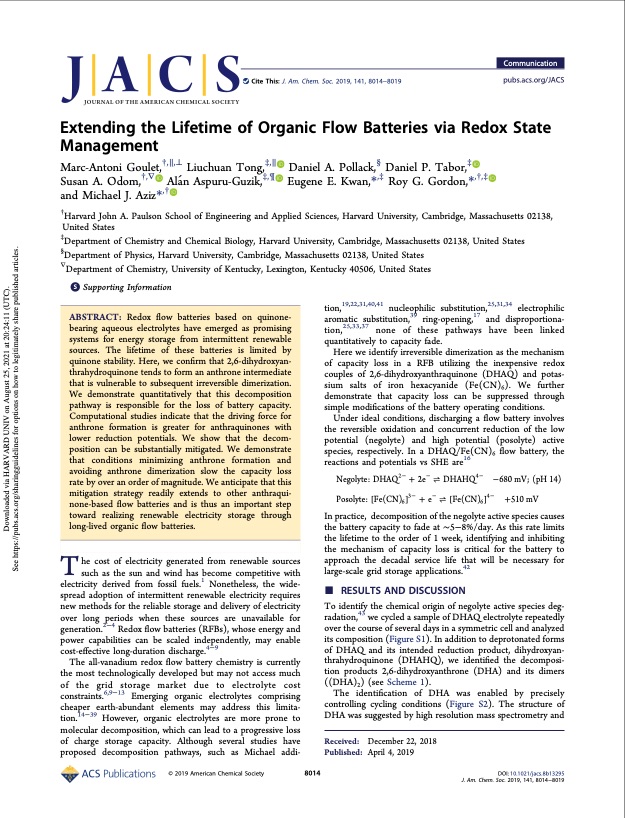
PDF Publication Title:
Text from PDF Page: 001
*S Supporting Information The cost of electricity generated from renewable sources such as the sun and wind has become competitive with electricity derived from fossil fuels.1 Nonetheless, the wide- spread adoption of intermittent renewable electricity requires new methods for the reliable storage and delivery of electricity over long periods when these sources are unavailable for generation.2−4 Redox flow batteries (RFBs), whose energy and power capabilities can be scaled independently, may enable cost-effective long-duration discharge.4−9 The all-vanadium redox flow battery chemistry is currently the most technologically developed but may not access much of the grid storage market due to electrolyte cost constraints.6,9−13 Emerging organic electrolytes comprising cheaper earth-abundant elements may address this limita- tion.14−39 However, organic electrolytes are more prone to molecular decomposition, which can lead to a progressive loss of charge storage capacity. Although several studies have proposed decomposition pathways, such as Michael addi- © 2019 American Chemical Society 8014 RESULTS AND DISCUSSION To identify the chemical origin of negolyte active species deg- radation,43 we cycled a sample of DHAQ electrolyte repeatedly over the course of several days in a symmetric cell and analyzed its composition (Figure S1). In addition to deprotonated forms of DHAQ and its intended reduction product, dihydroxyan- thrahydroquinone (DHAHQ), we identified the decomposi- tion products 2,6-dihydroxyanthrone (DHA) and its dimers ((DHA)2) (see Scheme 1). The identification of DHA was enabled by precisely controlling cycling conditions (Figure S2). The structure of DHA was suggested by high resolution mass spectrometry and Cite This: J. Am. Chem. Soc. 2019, 141, 8014−8019 pubs.acs.org/JACS Extending the Lifetime of Organic Flow Batteries via Redox State Management Marc-Antoni Goulet,†,∥,⊥ Liuchuan Tong,‡,∥ Daniel A. Pollack,§ Daniel P. Tabor,‡ Susan A. Odom,†,∇ Alań Aspuru-Guzik,‡,¶ Eugene E. Kwan,*,‡ Roy G. Gordon,*,†,‡ and Michael J. Aziz*,† †Harvard John A. Paulson School of Engineering and Applied Sciences, Harvard University, Cambridge, Massachusetts 02138, United States ‡Department of Chemistry and Chemical Biology, Harvard University, Cambridge, Massachusetts 02138, United States §Department of Physics, Harvard University, Cambridge, Massachusetts 02138, United States ∇Department of Chemistry, University of Kentucky, Lexington, Kentucky 40506, United States tion,19,22,31,40,41 nucleophilic substitution,25,31,34 electrophilic aromatic substitution,39 ring-opening,17 and disproportiona- tion,25,33,37 none of these pathways have been linked quantitatively to capacity fade. Here we identify irreversible dimerization as the mechanism of capacity loss in a RFB utilizing the inexpensive redox couples of 2,6-dihydroxyanthraquinone (DHAQ) and potas- sium salts of iron hexacyanide (Fe(CN)6). We further demonstrate that capacity loss can be suppressed through simple modifications of the battery operating conditions. Under ideal conditions, discharging a flow battery involves the reversible oxidation and concurrent reduction of the low potential (negolyte) and high potential (posolyte) active species, respectively. In a DHAQ/Fe(CN)6 flow battery, the reactions and potentials vs SHE are16 Negolyte: DHAQ2− + 2e− F DHAHQ4− −680 mV; (pH 14) Posolyte: [Fe(CN) ]3− + e− F [Fe(CN) ]4− +510 mV In practice, decomposition of the negolyte active species causes the battery capacity to fade at ∼5−8%/day. As this rate limits the lifetime to the order of 1 week, identifying and inhibiting the mechanism of capacity loss is critical for the battery to approach the decadal service life that will be necessary for l■arge-scale grid storage applications.42 Communication ABSTRACT: Redox flow batteries based on quinone- bearing aqueous electrolytes have emerged as promising systems for energy storage from intermittent renewable sources. The lifetime of these batteries is limited by quinone stability. Here, we confirm that 2,6-dihydroxyan- thrahydroquinone tends to form an anthrone intermediate that is vulnerable to subsequent irreversible dimerization. We demonstrate quantitatively that this decomposition pathway is responsible for the loss of battery capacity. Computational studies indicate that the driving force for anthrone formation is greater for anthraquinones with lower reduction potentials. We show that the decom- position can be substantially mitigated. We demonstrate that conditions minimizing anthrone formation and avoiding anthrone dimerization slow the capacity loss rate by over an order of magnitude. We anticipate that this mitigation strategy readily extends to other anthraqui- none-based flow batteries and is thus an important step toward realizing renewable electricity storage through long-lived organic flow batteries. 66 Received: December 22, 2018 Published: April 4, 2019 DOI: 10.1021/jacs.8b13295 J. Am. Chem. Soc. 2019, 141, 8014−8019 Downloaded via HARVARD UNIV on August 25, 2021 at 20:24:11 (UTC). See https://pubs.acs.org/sharingguidelines for options on how to legitimately share published articles.PDF Image | Extending organic flow batteries via redox state management

PDF Search Title:
Extending organic flow batteries via redox state managementOriginal File Name Searched:
mja287.pdfDIY PDF Search: Google It | Yahoo | Bing
Salgenx Redox Flow Battery Technology: Salt water flow battery technology with low cost and great energy density that can be used for power storage and thermal storage. Let us de-risk your production using our license. Our aqueous flow battery is less cost than Tesla Megapack and available faster. Redox flow battery. No membrane needed like with Vanadium, or Bromine. Salgenx flow battery
| CONTACT TEL: 608-238-6001 Email: greg@salgenx.com | RSS | AMP |